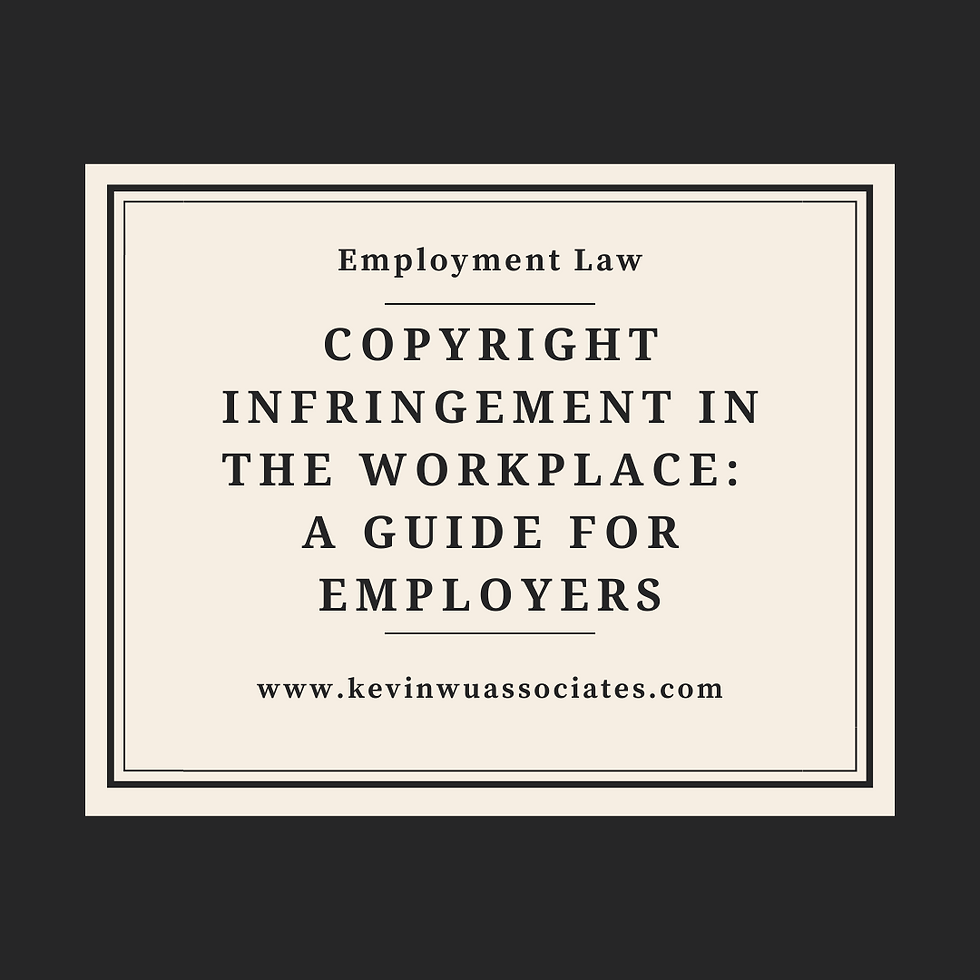What is Constructive Dismissal
- Kevin Wu & Associates

- Apr 21, 2021
- 4 min read
Updated: Dec 2, 2022
“Constructive dismissal” is defined as “actions taken by an employer that intentionally make working conditions for an employee difficult or unfair so that the employee feels forced to leave their job”[1].
In essence, a constructive dismissal occurs when an employer substantially changes the terms of an employee’s employment contract which is not consented by the employee, either expressly or impliedly.
Actions that Constitute Constructive Dismissal
The following is a non-exhaustive list of the actions by the employer which would tantamount to a constructive dismissal :-
1. Demotion in rank and status
If it is a bona fide reassignment of position and duties under a reorganisation exercise, it is not regarded as a demotion[2].
2. Unilateral reduction in salary
A unilateral decision to reduce the employee’s salary substantially would constitute a constructive dismissal[3].
3. Sexual harassment
Sexual advancement made by the employer against the employee including talking about sex and trying to fondle the employee was held to amount to sexual harassment which constituted a constructive dismissal[4].
4. Reduction of job functions and responsibilities
The reduction of job functions and responsibilities due to the transfer of an employee to another position which was not done in good faith will constitute a constructive dismissal[5].
5. Deprivation of work and marginalisation
Being deprived of work to the extent of being marginalised and having no work to do could amount to a constructive dismissal[6].
6. Pestering employee to resign
Coercing the employee to resign by approaching the employee with letters of resignation would tantamount to a constructive dismissal[7].
The Elements to Prove Constructive Dismissal
In Malaysia, in order to succeed in a claim for constructive dismissal, the employee is required to prove that the employer is guilty of a breach which goes to the root of the employment contract or if the employer has evinced an intention no longer to be bound by it[8].
Hence, to claim for constructive dismissal, it must be fulfilled that the employer’s conduct amounts to a breach of fundamental term(s) of the employment contract and the aforesaid breach is sufficiently important to justify the employee’s resignation. The employee must have also left in response to the said breach (not for other unconnected reasons) and the employee’s termination of contract by the employee must be done promptly[9].
Rights of an Employee on Constructive Dismissal
Before an employee can institute a claim for constructive dismissal, the employee is required by law to give notice to the employer to remedy the breach[10]. An immediate action is required to avoid being declared that the employee has waived his rights for a legal action.
Upon issuance of the notice, the employee has sixty (60) days to file his or her claim with the Industrial Relations Department, failing which it will not be entertained by the Director General[11].
Remedies May Be Granted by the Industrial Court
It is established that an employee seeking legal redress under the Industrial Relations Act 1967 must claim for reinstatement as the primary remedy. However, in the case of constructive dismissal where reinstatement may not be possible, the Industrial Court may award backwages or compensation in lieu of reinstatement, or both.
It must be noted that in deciding on the quantum for backwages, one of the factors that the Industrial Court would consider is whether the claimant has been gainfully employed elsewhere after his or her dismissal.
Consequences on Non-Compliance of the Award by the Industrial Court
If the award granted by the Industrial Court is not complied with, the person who fails to abide by the award will be liable to a term of imprisonment not exceeding two (2) years or to a fine not exceeding RM50,000.00 or both[12].
Filing of Appeal against the Award by the Industrial Court
Parties who are not satisfied with the Industrial Court’s decision may appeal to the High Court within fourteen (14) days from date of receipt of the award[13].
A mere assumption on constructive dismissal is not sufficient to institute a claim in the Industrial Court. In any circumstances, it is advisable to obtain legal consultation before an employee claims for a constructive dismissal. This is especially because an allegation for constructive dismissal is required to be proven at a higher threshold.
[1] https://dictionary.cambridge.org/dictionary/english/constructive-dismissal [2] Mak Weng Kit v Reed Exhibition Sdn Bhd [2000] 1 MLJ 715 [3] Forari Corporation Sdn. Bhd. v Sharil Bin Harun [1988] 2 ILR 404 [4] Khoo Ee Peng v Galaxy Automation Sdn Bhd [2009] 2 LNS 0656 [5] Habibah bte Mohd Zaman v Pan Global Insurance Bhd [2001] 6 MLJ 339 [6] Bayer (M) Sdn Bhd v Rugayah bte Parman [2000] 3 MLJ 91 [7] Michael Brian Davis v Microsoft (M) Sdn Bhd [2000] 3 MLJ 669 [8] Wong Chee Hong v Cathay Organisation (M) Sdn Bhd [1988] 1 MLJ 92 [9] Anwar Abdul Rahim v Bayer (M) Sdn Bhd [1998] 2 CLJ 197 [10] Southern Bank Bhd v Ng Keng Lian & Anor [2002] 5 MLJ 553 [11] Section 20(1A) Industrial Relations Act 1967 [12] Section 60(1) Industrial Relations Act 1967 (as amended by Industrial Relations (Amendment) Act 2020) [13] Section 33C(1) Industrial Relations Act 1967 (as amended by Industrial Relations (Amendment) Act 2020)
Authored by Nicholas Teh & Aaron Thye
Kindly note that this legal article does not, and is not intended to, constitute formal legal advice by the Firm, instead all information, content and materials available on this site are for general informational purposes only. If readers require further clarification or legal advice, please email office@kevinwuassociates.com.




